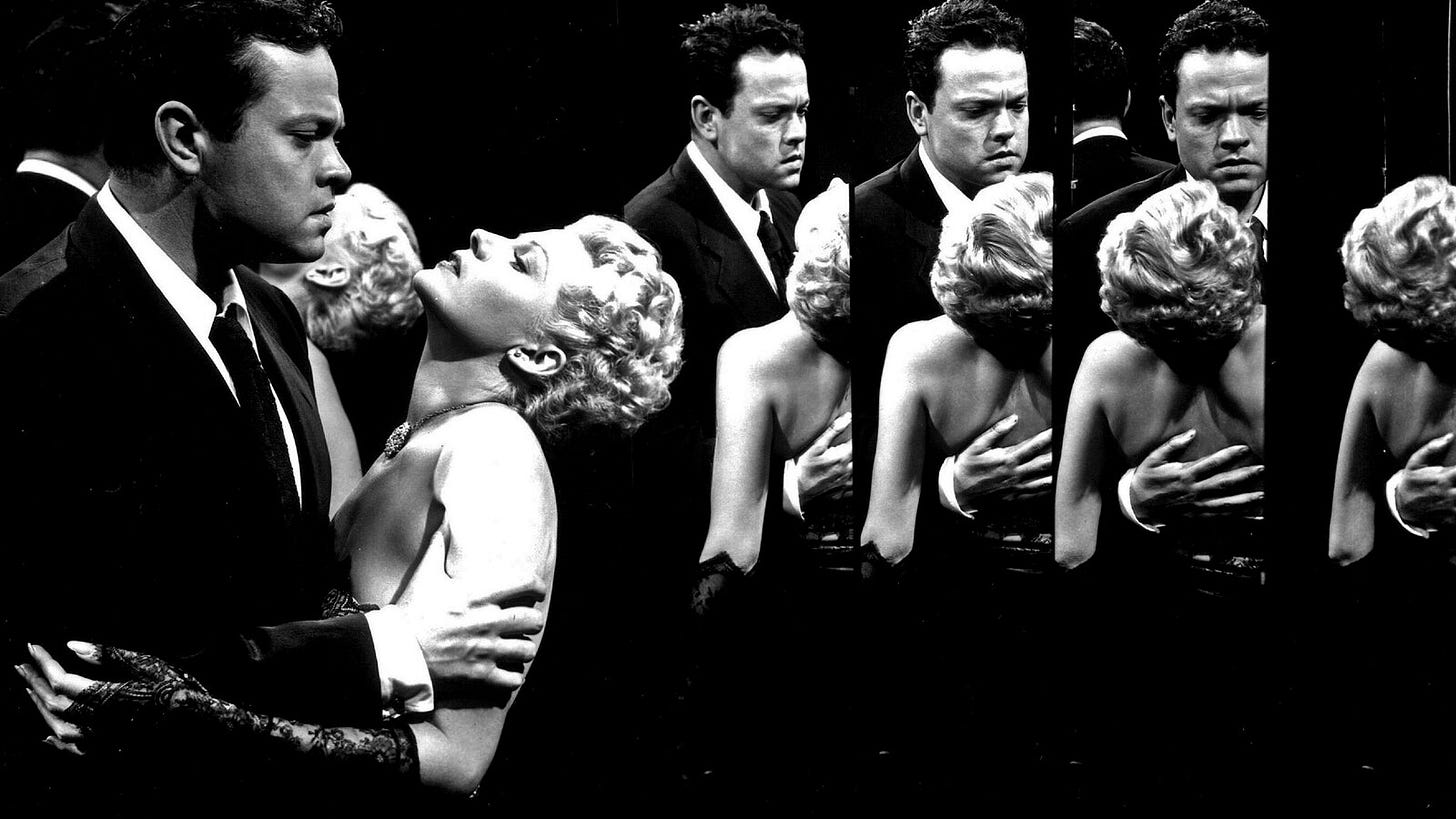Rita Hayworth Column: The Dream of Elsa Bannister in 'The Lady from Shanghai'
In the complex Orson Welles production, Rita Hayworth puts on a stunning performance that turns Gilda on her head.
Orson Welles’ The Lady from Shanghai is a formidable thing.
The film’s broad outline reflects a fairly common noir sketch of a morally corrupt and dangerous world hinging on the desires of a scheming femme fatale. The film opens in New York with Michael (Welles, in the role of an Irish longshoreman) coming across Elsa Bannister (Rita Hayworth’s blonde and statuesque femme fatale), who is taking a horse-drawn ride through Central Park in the evening. As soon as Michael’s eyes fall upon Elsa, he is more than smitten: “Once I’d seen her, once I’d seen her, I was not in my right mind for quite some time.” In typical noir fashion, he is immediately ready to give up, or perhaps destroy, the world for her. After a shambled robbery attempt, intended by Welles to be a sexual assault that never got past the Hays Code, against Elsa from which Michael rescues her, the two get to know each other as Michael takes Elsa to her car.
Elsa takes a liking to the charming and obviously smitten Michael and asks him to work as a seaman on her and her husband’s yacht: they’re to sail through the Panama Canal to San Francisco. Michael, learning that the beautiful woman has a husband, is disheartened and refuses her employment. The next day, Elsa sends her husband, Arthur Bannister (Everett Sloane), a famed criminal defense attorney, to the dock where Michael, an aspiring novelist, waits for work. Arthur successfully convinces Michael to take the job on the Bannister yacht. A strange journey ensues. The Bannisters are joined on their trip by Arthur's law partner, George Grisby (Glenn Anders), and the three — Elsa, Arthur, and George — make for a macabre trio. Each of them seems to passionately hate the other; they spend all their time torturing each other and themselves with barbed words, dragging Michael into their strange dance, too. Elsa is as if trapped by Arthur, who, aware of Michael’s feelings for Elsa, at times taunts the two, almost daring them to have an affair. Arthur seems to not love Elsa at all, and often hints at Elsa’s past as though he were using it as blackmail to keep the woman gelled to him under threat of its exposure.
Soon, Michael is dragged irrevocably deeper into their crazed lives when George asks Michael to help him fake his own death. Michael agrees because George promises to pay him a sum that might allow Michael to run away with Elsa, who throughout the trip has been inflaming Michael’s love and begging him to take her away from her cruel husband. The curious suicide plot turns swiftly into a murder plot that traps Michael as a befuddled fall guy. Arthur defends Michael during his trial, from which Michael escapes to Chinatown, where Elsa finds him. The film ends with a shoot-out in a hall of mirrors after it is revealed that the plot was all Elsa’s attempt to kill her husband.
Today, the film is lauded as a classic, but upon release in 1947, was panned: many critics found the story either confounding or overworked, and Welles’ narration as Michael overbearing. But the thing is, the film isn’t crafted for passive viewing, and the feeling of confusion is very much the point. Crucially, the film turns our expectations of lead Rita Hayworth on their head. Hayworth presents a kind of femme fatale who keeps pace with Welles’ artistic work in her complexity and meaningfulness, offering a woman simultaneously new and familiar, simultaneously dear and frightening. Hayworth’s Elsa Bannister is certainly a femme fatale fatally doomed and aware of her doom in the way I have argued is a type Hayworth excelled at playing, a woman possessing self-awareness in a lethal, self-destructive dose. But what is more interesting and captivating is Hayworth’s femme’s interplay with Welles’ work — the Brechtian ideology that he baked into the film intended to frustrate how we watch and interpret the film — to which is attendant a sly self-awareness. In The Lady from Shanghai, Hayworth works with Brechtian self-awareness to thumb her nose at those who caged her within the image of Gilda.
Brechtian Inspiration
If The Lady from Shanghai feels disorienting, heady, or strange, that’s because
Keep reading with a 7-day free trial
Subscribe to Film Daze to keep reading this post and get 7 days of free access to the full post archives.




